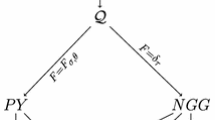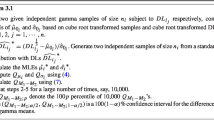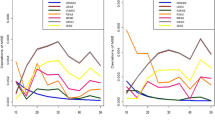Abstract
In this paper, the generalized exponential power (GEP) density is proposed as an importance function in Monte Carlo simulations in the context of estimation of posterior moments of a location parameter. This density is divided in five classes according to its tail behaviour which may be exponential, polynomial or logarithmic. The notion of p-credence is also defined to characterize and to order the tails of a large class of symmetric densities by comparing their tails to those of the GEP density.
The choice of the GEP density as an importance function allows us to obtain reliable and effective results when p-credences of the prior and the likelihood are defined, even if there are conflicting sources of information. Characterization of the posterior tails using p-credence can be done. Hence, it is possible to choose parameters of the GEP density in order to have an importance function with slightly heavier tails than the posterior. Simulation of observations from the GEP density is also addressed.
Similar content being viewed by others
References
Angers J.-F. 1992. Use of Student-t prior for the estimation of normal means: A computational approach, in Bayesian Statistic IV. Bernardo J.M., Berger J.O., David A.P., and Smith A.F.M. (Eds.), Oxford University Press, New York, pp. 567–575.
Angers J.-F. 1996. Protection against outliers using a symmetric stable law prior, in IMS Lecture Notes—Monograph Series Vol. 29, pp. 273–283.
Angers J.-F. 2000. P-Credence and outliers. Metron 58: 81–108.
Angers J.-F. and Berger J.O. 1991. Robust hierarchical Bayes estimation of exchangeable means. The Canadian Journal of Statistics 19: 39–56.
Box G. and Tiao G. 1962. A further look at robustness via Bayes’s theorem. Biometrika 49: 419–432.
Carlin B. and Polson N. 1991. Inference for nonconjugate Bayesian models using the Gibbs sampler. The Canadian Journal of Statistics 19: 399–405.
Desgagné A. and Angers J.-F. 2003. Computational aspect of the generalized exponential power density. Tech. rep., Report No. CRM-2918, Université de Montréal (http://www. crm.umontreal.ca/pub/Rapports/2900-2999/2918.pdf).
Fan T.H. and Berger J.O. 1992. Behaviour of the posterior distribution and inferences for a normal means with t prior distributions. Statistics & Decisions 10: 99–120.
Geweke J. 1994. Priors for macroeconomic time series and their applications. Econometric Theory 10: 609–632.
Johnson N.L., Kotz S., and Balakrishnan N. 1994. Continuous Univariate Distributions, (2nd edn.), Wiley, New York, Vol. 1.
Meinhold R. and Singpurwalla N. 1989. Robustification of Kalman filter models. Journal of the American Statistical Association 84: 479–486.
O’hagan A. 1990. Outliers and credence for location parameter inference. Journal of the American Statistical Association 85: 172–176.
Reiss R.-D. and Thomas M. 1997. Statistical Analysis of Extreme Values. Birkhauser Verlag, Basel.
Robert C. 1996. Méthodes de Monte Carlo par Chaînes de Markov. Economica, Paris.
Ross S.M. 1997. Simulation, (2nd edn.), Academic Press, San Diego.
Author information
Authors and Affiliations
Corresponding author
Rights and permissions
About this article
Cite this article
Desgagné, A., Angers, JF. Importance sampling with the generalized exponential power density. Stat Comput 15, 189–196 (2005). https://doi.org/10.1007/s11222-005-1308-7
Received:
Accepted:
Issue Date:
DOI: https://doi.org/10.1007/s11222-005-1308-7




